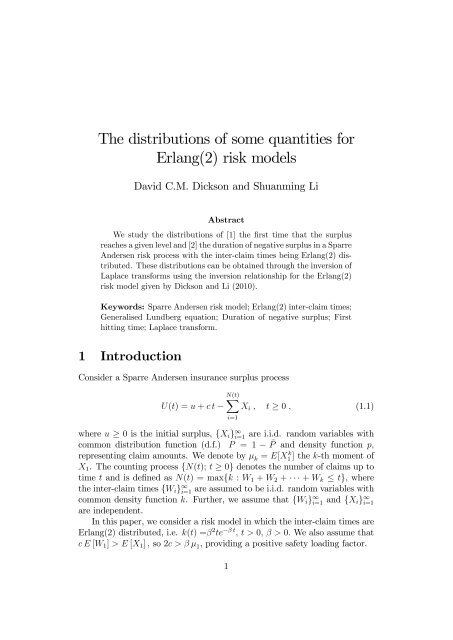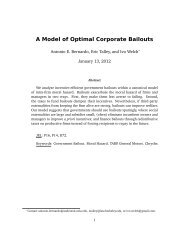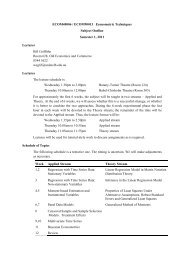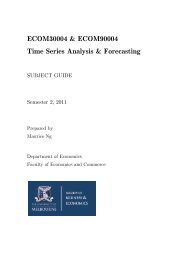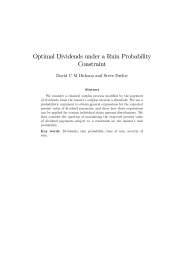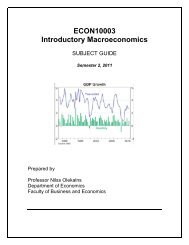The distributions of some quantities for Erlang(2) risk models
The distributions of some quantities for Erlang(2) risk models
The distributions of some quantities for Erlang(2) risk models
Create successful ePaper yourself
Turn your PDF publications into a flip-book with our unique Google optimized e-Paper software.
<strong>The</strong> <strong>distributions</strong> <strong>of</strong> <strong>some</strong> <strong>quantities</strong> <strong>for</strong><strong>Erlang</strong>(2) <strong>risk</strong> <strong>models</strong>David C.M. Dickson and Shuanming LiAbstractWe study the <strong>distributions</strong> <strong>of</strong> [1] the …rst time that the surplusreaches a given level and [2] the duration <strong>of</strong> negative surplus in a SparreAndersen <strong>risk</strong> process with the inter-claim times being <strong>Erlang</strong>(2) distributed.<strong>The</strong>se <strong>distributions</strong> can be obtained through the inversion <strong>of</strong>Laplace trans<strong>for</strong>ms using the inversion relationship <strong>for</strong> the <strong>Erlang</strong>(2)<strong>risk</strong> model given by Dickson and Li (2010).Keywords: Sparre Andersen <strong>risk</strong> model; <strong>Erlang</strong>(2) inter-claim times;Generalised Lundberg equation; Duration <strong>of</strong> negative surplus; Firsthitting time; Laplace trans<strong>for</strong>m.1 IntroductionConsider a Sparre Andersen insurance surplus processU(t) = u + c tN(t)XX i ; t 0 ; (1.1)i=1where u 0 is the initial surplus, fX i g 1 i=1 are i.i.d. random variables withcommon distribution function (d.f.) P = 1 P and density function p;representing claim amounts. We denote by k = E[X k 1 ] the k-th moment <strong>of</strong>X 1 . <strong>The</strong> counting process fN(t); t 0g denotes the number <strong>of</strong> claims up totime t and is de…ned as N(t) = maxfk : W 1 + W 2 + + W k tg; wherethe inter-claim times {W i g 1 i=1 are assumed to be i.i.d. random variables withcommon density function k. Further, we assume that fW i g 1 i=1 and fX i g 1 i=1are independent.In this paper, we consider a <strong>risk</strong> model in which the inter-claim times are<strong>Erlang</strong>(2) distributed, i.e. k(t) = 2 te t ; t > 0; > 0: We also assume thatc E [W 1 ] > E [X 1 ] ; so 2c > 1 , providing a positive safety loading factor.1
De…ne T to be the time <strong>of</strong> ruin from initial surplus u so that T = infft :U(t) < 0 j U(0) = ug, with T = 1 if U(t) 0 <strong>for</strong> all t 0: We de…ne(u) = P (T < 1) to be the ultimate ruin probability.LetG(u; y) = P (T < 1; jU(T )j y j U(0) = u)so that G(u; y) represents the probability that ruin occurs from initial surplusu with a de…cit at ruin <strong>of</strong> no more than y. We denote its (defective) densityas g(u; y): Let Y denote the de…cit at ruin given that ruin has occurred.<strong>The</strong>n G(u; y) = G(u; y)= (u) and g(u; y) = g(u; y)= (u) are the distributionfunction and the density function <strong>of</strong> Y , respectively.In this paper we consider the distribution <strong>of</strong> the …rst hitting time <strong>of</strong> thesurplus process through level x > 0, starting from u = 0, and the relatedproblem <strong>of</strong> the distribution <strong>of</strong> the duration <strong>of</strong> periods <strong>of</strong> negative surplus.This leads to the problem <strong>of</strong> calculating the distribution <strong>of</strong> the total duration<strong>of</strong> negative surplus. By a symmetry argument, the distribution <strong>of</strong> the …rsthitting time <strong>for</strong> our <strong>risk</strong> model is the same as the distribution <strong>of</strong> the ruintime in a dual <strong>risk</strong> model given byN(t)XU D (t) = x c t + X i ; t 0 ;where the condition 2c > 1 <strong>for</strong> the insurance surplus process would bereplaced by 2c < 1 : See Cheung (2010), <strong>for</strong> example, <strong>for</strong> a discussion <strong>of</strong>dual <strong>risk</strong> <strong>models</strong>.Let ^a(s) = R 10e sx a(x) dx denote the Laplace trans<strong>for</strong>m <strong>of</strong> a function a.i=12 <strong>The</strong> …rst hitting timeDe…neT x = infft > 0 : U(0) = 0; U(t) xg; x > 0;to be the …rst time that the surplus process upcrosses through level x, andde…ne <strong>for</strong> > 0R (x) = E e Tx U(0) = 0to be the Laplace trans<strong>for</strong>m <strong>of</strong> T x . Li (2008) shows thatR (x) = r 2 =ce r1x + r 1 =ce r2x ; x > 0; (2.1)r 2 r 1 r 1 r 22
where r 1 and r 2 are the two positive solutions <strong>of</strong> Lundberg’s fundamentalequation: 2 + s= 2^p(s): (2.2)c c2 We know from Dickson and Hipp (2001) that 0 < r 1 < ( + )=c < r 2 andr 1 = + cr 2 = + cc ^q(r 1);+ c ^q(r 2);where ^q(s) = p^p(s):Let us rewrite equation (2.1) in a di¤erent <strong>for</strong>m:Similarly, we can writeR (x) = e r 1x r 1 =cr 1 r 2e r 1xe r 2x = e r 1x c (1 ^q(r 1)) e r 1xe r 2xr 1 r 2: (2.3)R (x) = e r 2x<strong>The</strong>se lead to a third <strong>for</strong>mulation, namelyc (1 + ^q(r 2)) e r 1xe r 2x: (2.4)r 1 r 2R (x) = 1 2 e r1x + e r 2x+ 2c (2 ^q(r 1) + ^q(r 2 )) e r 1xe r 2x: (2.5)r 2 r 1This is our preferred equation <strong>for</strong> R (x) since it is symmetric in r 1 and r 2 ,unlike equations (2.3) and (2.4). As we shall see, the main task in invertingR (x) is dealing with (e r 1xe r2x )=(r 2 r 1 ). This term arises in relatedLaplace trans<strong>for</strong>ms <strong>for</strong> the <strong>Erlang</strong>(2) <strong>risk</strong> model, as shown by Sun (2005).We can apply the method in Dickson and Li (2010) to invert the Laplacetrans<strong>for</strong>m in (2.5) to obtain the distribution <strong>of</strong> T x . Dickson and Li (2010)show that ifthen^f(r 1 ) =Z 1g(t) = ce t f(ct) +0e r 1t f(t)dt = ^g() =1X n t nn=11 e t Z ctn!30Z 10e t g(t)dt; (2.6)yq n (ct y)f(y)dy; (2.7)
where q n denotes the n-fold convolution <strong>of</strong> q. Further, if^f(r 2 ) =thenZ 1e r 2t f(t)dt = ^h() =Z 1001Xh(t) = ce t ( ) n t n 1 e tf(ct) +n!n=1Z ct0e t h(t)dt; (2.8)yq n (ct y)f(y)dy: (2.9)From these results, Dickson and Li (2012) observe that ^q(r 1 )inverse <strong>of</strong> a function n given by^q(r 2 ) is then(t) = 2c1X (t) 2mm=1(2m)!1 e tq 2m (ct):Similarly, ^q(r 1 ) + ^q(r 2 ) is the inverse <strong>of</strong> a function m given bym(t) = 2c1Xn=0(t) 2n e t(2n + 1)! q(2n+1) (ct):3 <strong>The</strong> density <strong>of</strong> the …rst hitting timeIn this section we …rst …nd general expressions <strong>for</strong> the density <strong>of</strong> the …rsthitting time T x by inverting its Laplace trans<strong>for</strong>m, then we simplify ourresults <strong>for</strong> <strong>Erlang</strong>(2) claims. Consider …rst inversion <strong>of</strong> e r1x . <strong>The</strong> equationsatis…ed by r 1 is + cr 1 = ^q(r 1 );which is <strong>of</strong> exactly the same <strong>for</strong>m as Lundberg’s fundamental equation <strong>for</strong> theclassical <strong>risk</strong> model. It there<strong>for</strong>e follows from Dickson and Willmot (2005)thate r 1x= e (+)x=c += e (+)x=c +1X (=c) nxn!n=1Z 1x=cZ 10e t x t e(ct(y + x) n 1 e (+)(y+x)=c q n (y)dyx; t)dtwhere1Xe(x; t) = en=1t (t)nq n (x)n!4
is a compound Poisson density function. Thus, the inverse <strong>of</strong> e r1x isex=c<strong>for</strong> t = x=c;h x+ (t) =e(ct x; t) <strong>for</strong> t > x=c:xtThis is just the well-known result from the classical <strong>risk</strong> model where theLaplace trans<strong>for</strong>m <strong>of</strong> T x is e x where is the unique positive solution <strong>of</strong>Lundberg’s fundamental equation <strong>for</strong> that model. (See Gerber and Shiu(1998).)Similarly, the inverse <strong>of</strong> e r2x is h x (t) where ex=ch x (t) = P 1n=1 e t (xt<strong>for</strong> t = x=c;1) n (t) nq n (ctn!x) = h x (t) <strong>for</strong> t > x=c:Hence the inverse <strong>of</strong> (e r1x + e r2x ) =2 is(ex=c<strong>for</strong> t = x=c; x (t) = Px 1t n=1 e t (t) 2n(2n)! q2n (ct x) = x (t) <strong>for</strong> t > x=c;(3.1)(3.2)and the inverse <strong>of</strong> (e r 1x x (t) = x t1Xen=1Now let A x (t) be such thate r 2x ) =2 ist (t)2n1(2n 1)! q(2n 1) (ct x) <strong>for</strong> t > x=c. (3.3)Z 1To …nd A x (t) we note thate r 1xSimilarly,e r 2x0e t A x (t)dt = e r 1xe r 2xr 2 r 1:= e r 1x e (r 2 r 1 )x1r 2 r 1 r 2 r 11X= e r ( 1)1xn x n(r 2 r 1 ) n 1n!n=11X = e r ( 1)1xn x n n 1 (^q(r 1 ) + ^q(r 2 )) n 1n! cn=11X = e r ( 1)1xn x nn 1 ^m():n! ce r 1xe r 2xn=1r 2 r 1= e r 2x1Xn=15x nn! n 1 ^m(); (3.4)c
givinge r 1xe r 2x= 1 1X x nn 1 ^m()( 1) n 1 e r1x + e r 2xr 2 r 1 2 n! cn=1= x 2 e r1x + e r 2x+ 1 1Xx 2n+1 ^m()2 (2n + 1)! cn=111X x 2n2n 1 ^m()e r 1xe r 2x:2 (2n)! cn=1 2ne r 1x + e r 2x Hence by <strong>for</strong>mulae (3.2) and (3.3), <strong>for</strong> t > x=cA x (t) = x x (t) +1Xn=1(x=c) 2n(2n + 1)! x m 2n (t)1X (x=c) 2n 1(2n)! x m (2nn=11) (t)!;with A x (x=c) = x e x=c . Finally, let f Txinversion <strong>of</strong> (2.5) givesbe the density function <strong>of</strong> T x : <strong>The</strong>n<strong>for</strong> t > x=c, withf Tx (t) = x (t) + c A x(t)2c n A x(t) (3.5)Pr(T x = x=c) = x (x=c) + c A x(x=c) = e x=c (1 + x=c) = Pr(W 1 > x=c):Although <strong>for</strong>mula (3.5) is a general result, it is a <strong>for</strong>mula that is not easilyimplemented, even <strong>for</strong> simple claim size <strong>distributions</strong> like the exponentialdistribution. As an alternative approach to …nding A x (t), we can use thefact that ^m() = ^q(r 1 ) + ^q(r 2 ) to write <strong>for</strong>mula (3.4) as1X !me r 2x x m+1x +c (m + 1)! (^q(r 1) + ^q(r 2 )) m= xe r 2x1 +m=11X m x mcm=1Now let B k;m (t) be such thatZ 10(m + 1)!mX !m^q(r 1 ) m j ^q(r 2 ) j :jj=0e t B k;m (t) dt = ^q(r 1 ) k ^q(r 2 ) m6
<strong>for</strong> k = 0; 1; 2; : : : and m = 0; 1; 2; : : : so that the inverse <strong>of</strong>1X m x m mX m^q(r 1 ) m j ^q(r 2 ) jc (m + 1)! jm=1j=0is a function B x given by1X m x mB x (t) =c (m + 1)!This givesm=1mXj=0A x (t) = x h x (t) + x h x B x (t)x ex=c=x h x (t) + x h x B x (t) mjB mj;j (t):<strong>for</strong> t = x=c;<strong>for</strong> t > x=c:(3.6)From Dickson and Li (2010, 2012) we know how to …nd B k;m (t) <strong>for</strong> certainclaim size <strong>distributions</strong>.Example 1 Let p(x) = 2 xe x , so that q(x) = e x and ^q(r) = =(+r).Dickson and Li (2012) de…ne C n;m (t) be the inverse <strong>of</strong> 1=(r 1 + ) n+1 (r 2 +) m+1 ; and show thatwhere l;n;m =j=0C n;m (t) = c 2 t(ct) n+m e (+c)t1Xl=0(ct 2 ) l l;n;m(n + m + 2l + 2)lX n + 2j + 1 n + 1 m + 2(l j) + 1( 1) l j m + 1j n + 2j + 1 l j m + 2(l j) + 1 :Using these results, the inverse <strong>of</strong>1X m x mcism=1B x (t) =1X cm=1(m + 1)! mmXj=0x m(m + 1)! mj^q(r 1 ) mmXj=0j ^q(r 2 ) j mjC m j 1;j 1 (t):As q n (x) = n x n 1 e x = (a); it is straight<strong>for</strong>ward to write down expressions<strong>for</strong> x (t), h x (t) and n(t), and to express these in terms <strong>of</strong> hypergeometricfunctions. Although the convolutions in <strong>for</strong>mulae (3.5) and (3.6) lead torather messy <strong>for</strong>mulae, it is not a di¢ cult task to evaluate these convolutionsby numerical integration. Of course, numerical implementation requires thatin…nite sums are truncated at an appropriate point.7
4 <strong>The</strong> distribution <strong>of</strong> the duration <strong>of</strong> periods<strong>of</strong> negative surplus4.1 Conditional <strong>distributions</strong>In this section, we study the density <strong>of</strong> the duration <strong>of</strong> a period <strong>of</strong> negativesurplus, given that the surplus process falls below 0. For the surplus processfU(t)g t0 ; if ruin occurs at time T , the process will cross level 0 at timeT + T 1 <strong>for</strong> the …rst time, where T 1 is the duration <strong>of</strong> the …rst period <strong>of</strong>negative surplus. Let T j , <strong>for</strong> j = 2; 3; : : : ; be the duration <strong>of</strong> the j-th period<strong>of</strong> negative surplus. <strong>The</strong> distribution <strong>of</strong> T j depends on the initial surplus,as this a¤ects the phase <strong>of</strong> the <strong>Erlang</strong>(2) inter-arrival distribution when thesurplus upcrosses level 0 be<strong>for</strong>e the surplus drops below 0 <strong>for</strong> the j-th time.LethiD (u) = E e T 1j T < 1be the Laplace trans<strong>for</strong>m <strong>of</strong> T 1 with respect to ( 0): <strong>The</strong>nD (u) ===Z 10Z 10Z 1Substituting (2.5) into (4.1) yields0Ehie T 1jY = y g(u; y) dyE[e Ty ] g(u; y) dyR (y) g(u; y)dy: (4.1)D (u) = 1 2 (^g(u; r 1 ) + ^g(u; r 2 )) + 2c (2 ^q(r 1) + ^q(r 2 )) ^g(u; r 1 ) ^g(u; r 2 )r 2 r 1;(4.2)where ^g(u; r i ) = R 1e riy g(u; y)dy, <strong>for</strong> i = 1; 2; are the Laplace trans<strong>for</strong>ms0<strong>of</strong> g(u; y) with respect to r i .Let i (u) and g i (u; y) be the probability <strong>of</strong> ruin and the defective density<strong>of</strong> the de…cit at ruin <strong>for</strong> a modi…ed <strong>Erlang</strong>(2) surplus process in which thedistribution <strong>of</strong> the time to the …rst claim is <strong>Erlang</strong>(i), <strong>for</strong> i = 1; 2: Clearly2(u) = (u) and g 2 (u; y) = g(u; y): <strong>The</strong>n g i (u; y) = g i (u; y)= i (u); i = 1; 2;are the densities <strong>of</strong> the de…cit at ruin given that ruin has occurred <strong>for</strong> thesurplus process with the distribution <strong>of</strong> the time to the …rst claim being<strong>Erlang</strong>(i), <strong>for</strong> i = 1; 2, respectively.Let D (i); i = 1; 2; be the Laplace trans<strong>for</strong>m <strong>of</strong> T j <strong>for</strong> j = 2; 3; : : : ; giventhat the distribution <strong>of</strong> the time to the next claim from the last recovery time8
prior to the occurrence <strong>of</strong> the j-th period <strong>of</strong> negative surplus is <strong>Erlang</strong>(i).<strong>The</strong>nZ 1 hiD (i)= E e T jjY = y g i (0; y) dy; i = 1; 2:0Clearly D (2)= D (0), i.e. the density <strong>of</strong> T j <strong>for</strong> j = 2; 3; : : : ; is the same asthat <strong>of</strong> T 1 <strong>for</strong> u = 0 if the distribution <strong>of</strong> the time to the next claim fromthe last recovery time prior to the occurrence <strong>of</strong> the j-th period <strong>of</strong> negativesurplus is <strong>Erlang</strong>(2).In what follows, we show how to invert D (u) and D (1)with respect to to obtain the conditional density function <strong>of</strong> T 1 and T j <strong>for</strong> j = 2; 3; : : : intwo examples. We revisit these examples in Section 4.3.Example 2 Let p(x) = e x so that q(x) = p =(x)e x ; x > 0, and^q(s) = (=(s + )) 1=2 : It is well known that g(u; y) = e y , leading toD (u) = 1 2 r 1 + + + r 2 + 2c (2 ^q(r 1) + ^q(r 2 ))(r 1 + )(r 2 + ) :(4.3)It follows from Dickson and Li (2010) that the inverse <strong>of</strong> the …rst term withrespect to isX 1ce (+c)t (c 2 t 3 ) m1(2m)!(m + 1)! = ce (+c)t 0F 22 ; 2; c2 t 3;4wherem=0pF q (B 1 ; B 2 ; : : : ; B p ; C 1 ; C 2 ; : : : ; C q ; Z) =1Xm=0is the generalised hypergeometric function, with (a) n =the inverse <strong>of</strong> c(r 1 + )(r 2 + )is(B 1 ) m (B 2 ) m : : : (B p ) m Z m(C 1 ) m (C 2 ) m : : : (C q ) m m!(a + n)= (a), and 3ct e (+c)t 0F 22 ; 2; c2 t 3: (4.4)4Last,2c^q(r 1 ) ^q(r 2 )(r 1 + )(r 2 + )= 3=22c(r 1 + )(r 2 + )911:(r 1 + ) 1=2 (r 2 + ) 1=2(4.5)
From Dickson and Li (2010), the inverse <strong>of</strong> (r 1 + ) 1=2 is a function V 1 (t)given byV 1 (t) = e (+c)t 1X m t m 1 m=2 (ct) (m+1)=2m+12 m!+ 1 2m=0and the inverse <strong>of</strong> (r 2 + ) 1=2 is a function W 1 (t) given byW 1 (t) = e (+c)t21X ( ) m t m 1 m=2 (ct) (m+1)=2m+1m!+ 1 2m=0meaning that the inverse <strong>of</strong> (r 1 + ) 1=2 (r 2 + ) 1=2 is a function, say g(t),given by1Xg(t) = n e (+c)t t 3n+1wheren=0 n = 2n+1 n+1=2 c n+1(2n + 1)! (n + 2) :Hence the inverse <strong>of</strong> (4.5) is the convolution <strong>of</strong> g with a function h, wherefrom (4.4)1Xh(t) = h m e (+c)t t 3m+1wherem=0h m = 2m+1 m+3=2 c m+1:(2m + 2)! m!<strong>The</strong> Laplace trans<strong>for</strong>m (with parameter s) <strong>of</strong> the product <strong>of</strong> the m-th term <strong>of</strong>h(t) and the n-th term <strong>of</strong> g(t) isgivingwhere l =h m n(3m + 2) (3n + 2)( + c + s) 3(m+n)+4h g(t) =1Xl=0 le (+c)t t 3l+3(3l + 4)lXh m l m (3m + 2) (3 (l m) + 2)m=0lX= l+2 2l+2 c l+2 (3m + 1)! (3(l m) + 1)!(2m + 2)! m! (2(l m) + 1)!(l m + 1)!m=010
= l+2 2l+2 c l+22lX 3m + 2m=0m 23m + 2 3(l m) + 2l m + 113(l m) + 2 :(4.6)In order to express our …nal answer in terms <strong>of</strong> hypergeometric functions(and hence make computation straight<strong>for</strong>ward), it is necessary to express thesum in (4.6) in closed <strong>for</strong>m. As shown in the Appendix,givinglX 3m + 2m=0m 23m + 2h g(t) = 2 e (+c)t 3(l m) + 2l m + 11Xl=013(l m) + 2 l+2 2l+2 c l+2 t 3l+3l! (2l + 4)!=4 (3l + 3)!l! (2l + 4)!Simpli…cation givesh g(t) = 1 512 2 2 c 2 t 3 e (+c)t 0F 22 ; 3; c2 t 3and hence the inverse <strong>of</strong> (4.3) gives the density <strong>of</strong> T 1 as 1f T1 (u; t) = ce (+c)t 0F 22 ; 2; c2 t 33+ t 0 F 242 ; 2; c2 t 34 1512 2 2 c 2 t 3 e (+c)t 0F 22 ; 3; c2 t 3:4Remarks1. <strong>The</strong> distribution <strong>of</strong> the duration <strong>of</strong> the …rst period <strong>of</strong> negative surplusis independent <strong>of</strong> the initial surplus u due to the memoryless property<strong>of</strong> the exponential distribution.2. As g i (u; y) = g(u; y) = e y ; i = 1; 2; the distribution <strong>of</strong> the duration<strong>of</strong> other periods <strong>of</strong> negative surplus is the same as that <strong>of</strong> the duration<strong>of</strong> the …rst period <strong>of</strong> negative surplus.4Example 3 We now consider the case when p(x) = 2 xe x .from Li and Garrido (2004) or Sun (2005) thatIt followsg(u; y) = e y a 11 e R 1u + a 12 e R 2u + 2 ye y a 21 e R 1u + a 22 e R 2u ;11
where R 1 and R 2 are the negative solutions <strong>of</strong> 2 2s = 2 ; (4.7)c c 2 s + anda 11 =a 12 =a 21 =a 22 = 2c 2 (r + ) 2 (3 + 2r) R 1 (r + 2)R 2 R 1; 2c 2 (r + ) 2 (3 + 2r) R 2 (r + 2)R 1 R 2; R 1;c 2 (r + ) R 2 R 1 2 2 R 2;c 2 (r + ) R 1 R 2with r > 0 being the positive solution <strong>of</strong> equation (4.7). <strong>The</strong> ultimate ruinprobability can be obtained as<strong>The</strong>nwhere(u) =FurtherZ 10g(u; y)dy = (a 11 + a 21 ) e R 1u + (a 12 + a 22 ) e R 2u ; u 0:g(u; y) =g(u; y)(u)= (u) e y + (1 (u)) 2 ye y ;(u) = a 11e R1u + a 12 e R 2u; u 0:(u) 2^g(u; r i ) = (u)r i + + (1 (u)) ; i = 1; 2;r i + so that <strong>for</strong>mula (4.2) simpli…es toD (u) = (u) 12 r 1 + + 1 + 2 (1 (u)) 1r 2 + 2 (r 1 + ) + 12 (r 2 + ) 2 (u)+c (r 1 + )(r 2 + ) + 2 (1 (u))c (r 1 + )(r 2 + ) + 2 (1 (u))2 c (r 1 + ) 2 (r 2 + ) 2 (u) 2 (u)+2c (r 1 + ) 2 (r 2 + ) 2c (r 1 + )(r 2 + ) 2+ 3 (1 (u)) 3 (1 (u))2c (r 1 + ) 3 (r 2 + ) 2c (r 1 + )(r 2 + ) : 3 (4.8)12
<strong>The</strong>n we can express the density <strong>of</strong> T 1 asf T1(u; t) = (u)2(C 0; 1 (t) + C 1;0 (t)) + 2 (1 (u))(C 1; 1 (t) + C 1;1 (t))2(u)=2)C 1;0 (t) + 2 (1c+ (u) C 0;0 (t) + 2 (1c+ 3 (1 (u))2c(C 2;0 (t) C 0;2 (t)) :As shown in Dickson and Li (2010, 2012) each <strong>of</strong> these C n;m functions canbe expressed in terms <strong>of</strong> hypergeometric functions.To …nd the density <strong>of</strong> the duration <strong>of</strong> other periods <strong>of</strong> negative surplus, weneed only …nd g 1 (0; y) as g 2 (0; y) = g(0; y): Dickson and Li (2012) give thebivariate Laplace trans<strong>for</strong>m <strong>of</strong> the time <strong>of</strong> ruin and the de…cit at ruin <strong>for</strong> themodi…ed surplus process in which the initial surplus is 0 and the distribution<strong>of</strong> the time to the …rst claim is exponential with parameter : Setting = 0and inverting this Laplace trans<strong>for</strong>m gives<strong>The</strong>nandwhereg 1 (0; y) = c(r + )2 2 (r + ) 2 e yc 2 (r + ) 21(0) =+Z 10c(r + ) + 2 2 ye y ; y > 0:c 2 (r + )g 1 (0; y)dy =2c(r + )2 2 ;c 2 (r + ) 2g 1 (0; y) = g 1(0; y)1(0) = 1e y + (1 1 ) 2 ye y ; y > 0; 1 = c(r + )2 (r + ) :2c(r + ) 2 3(u)=2)C 0;1 (t)c<strong>The</strong>n D (1)= R 1E[e T jjY = y]g0 1 (0; y)dy = R 1R0 (y)g 1 (0; y)dy and we can…nd an expression <strong>for</strong> D (1)by replacing (u) by 1 in (4.8). Let f (1)T 2bethe conditional density <strong>of</strong> the duration <strong>of</strong> other periods <strong>of</strong> negative surplus,conditioning on there being one phase <strong>of</strong> the <strong>Erlang</strong> distribution until thenext claim following the previous upcrossing <strong>of</strong> the surplus process through 0.13
where (0) = ( 1 (0); 2 (0)) with i (0) = 1 i (0):Now let u = e 2 (u) = ( (u) ^g(u; r)) ; (1 ) (u) + ^g(u; r)cr cr crand let I be the 2 2 identity matrix. Note that > (0) = [I (0)]1 > ;where 1 = (1; 1): <strong>The</strong>n the distribution <strong>of</strong> N can be re-expressed asPr(N = 0) = 1 u 1 > ;Pr(N = n) = u [ (0)] n 1 [I (0)] 1 > ; n = 1; 2; : : : :This shows that N follows a discrete phase-type distribution with representation( u ; (0)) :Example 4 Let p(x) = e x . <strong>The</strong>n it is well-known, e.g. Grandell (1991),that (u) = (1 R=)e Ru where R is the unique negative solution <strong>of</strong>and froms 1 (u) = 2 (u) 2= 2 c c 2 s + c d du 2(u)(see, <strong>for</strong> example, Dickson and Li (2012)) we obtain 1 (u) = (1+cR=) 2 (u).As g i (u; y) = i (u) e y , we have8 < cr cr(+r) i(u); j = 1; ij (u) = : 1i(u); j = 2:cr + cr(+r)When = 2; = 1 and c = 1:2 we have Pr(N = 0) = 1 (u), and <strong>for</strong>n = 1; 2; 3; : : :Pr(N = n) = 0:1698(0:8302 n 1 ) (u).4.3 Unconditional <strong>distributions</strong>We can use the same ideas as in Section 4.2 to …nd the distribution <strong>of</strong> thej-th period <strong>of</strong> negative surplus <strong>for</strong> j = 2; 3; 4; : : :. Let a j be a vector given bya j = e 2 (u) (0) j 2 :<strong>The</strong>n <strong>for</strong> i = 1; 2 the i-th element <strong>of</strong> a j is the probability that the (j 1)-thupcrossing <strong>of</strong> the surplus process through 0 occurs with i phases until thenext claim. Thus, with probability (a j ) 1 1 (0) the density <strong>of</strong> T j is f (1)T 2(t) and15
with probability (a j ) 2 2 (0) it is f T1(0; t). Thus, given that there is a j-thperiod <strong>of</strong> negative surplus, its density iswhereg j (t) = j f (1)T 2(t) + (1 j ) f T1(0; t) (4.9) j =(a j ) 1 1 (0)(a j ) 1 2 (0) + (a j ) 2 2 (0) :In principle, this allows us to specify the distribution <strong>of</strong> the total duration <strong>of</strong>negative surplus. <strong>The</strong> following examples illustrate contrasting situations.Example 5 Let p(x) = e x . <strong>The</strong>n we have noted that f T j g 1 j=1 are i.i.d.random variables. Consequently, the distribution <strong>of</strong> the total duration <strong>of</strong> negativesurplus is compound phase-type, meaning that we can use the recursive<strong>for</strong>mula proposed by Wu and Li (2010) to calculate this distribution by discretisingthe distribution <strong>of</strong> T 1 .Example 6 Let p(x) = 2 xe x . In this case we can calculate the elements<strong>of</strong> (u) usingc dg 1 (u; y) = g(u; y) g(u; y): duTable 4.1 shows the weight j <strong>for</strong> di¤erent values <strong>of</strong> j when u = 0 and 10;with = 2 and c = 1:1. As j increases, the value <strong>of</strong> j <strong>for</strong> each value <strong>of</strong>j j (u = 0) j (u = 10)2 0491300 0.4895983 0.527392 0.5273424 0.528454 0.5284535 0.528486 0.5284866 0.528487 0.5284877 0.528487 0.528487Table 4.1: Values <strong>of</strong> ju is unchanged (to the number <strong>of</strong> decimal places shown), suggesting that thee¤ect <strong>of</strong> the initial surplus on the distribution <strong>of</strong> T j quickly diminishes as jincreases. <strong>The</strong> total duration <strong>of</strong> negative surplus is now a random sum wherethe <strong>quantities</strong> being summed are not i.i.d. random variables. In such a situationconvolutions must be calculated numerically and there does not appearto be a neat approach to calculating the distribution <strong>of</strong> the total duration <strong>of</strong>negative surplus.16
References[1] Cheung, E.C.K. (2010) A unifying approach to the analysis <strong>of</strong> businesswith random gains. Scandinavian Actuarial Journal. In press.[2] Dickson, D.C.M. and Hipp, C. (2001) On the time to ruin <strong>for</strong> <strong>Erlang</strong>(2)<strong>risk</strong> processes. Insurance: Mathematics & Economics 29, 333–344.[3] Dickson, D.C.M. and Li, S. (2010) Finite time ruin problems <strong>for</strong> the<strong>Erlang</strong>(2) <strong>risk</strong> model. Insurance: Mathematics & Economics 46, 12–18.[4] Dickson, D.C.M. and Li, S. (2012) <strong>Erlang</strong> <strong>risk</strong> <strong>models</strong> and …nite timeruin problems. Scandinavian Actuarial Journal. In press.[5] Dickson, D.C.M. and Willmot, G.E. (2005) <strong>The</strong> density <strong>of</strong> the time toruin in the classical Poisson <strong>risk</strong> model. ASTIN Bulletin 35, 45–60.[6] Gerber, H.U. and Shiu, E.S.W. (1998) On the time value <strong>of</strong> ruin. NorthAmerican Actuarial Journal 2 (1), 48–78.[7] Graham, R.L., Knuth, D.E. and Patashnik, O. (1994) Concrete Mathematics,2nd edition. Addison-Wesley, Upper Saddle River, NJ.[8] Grandell, J. (1991) Aspects <strong>of</strong> Risk <strong>The</strong>ory. Springer-Verlag, New York.[9] Li, S. (2008) <strong>The</strong> time <strong>of</strong> recovery and the maximum severity <strong>of</strong> ruinin a Sparre Andersen model. North American Actuarial Journal 12 (4),413–424.[10] Li, S. and Garrido, J. (2004) On ruin <strong>for</strong> the <strong>Erlang</strong>( n) <strong>risk</strong> process.Insurance: Mathematics & Economics 34, 391–408.[11] Sun, L.-J. (2005) <strong>The</strong> expected discounted penalty at ruin in the <strong>Erlang</strong>(2)<strong>risk</strong> process. Statistics & Probability Letters 72, 205–217.[12] Wu, X. and Li, S. (2010) Matrix-<strong>for</strong>m recursions <strong>for</strong> a family <strong>of</strong> compound<strong>distributions</strong>. ASTIN Bulletin 40, 351–368.APPENDIXIn order evaluate the sum in (4.6), we make use <strong>of</strong> the generalised binomialseries B t (z) described in Graham et al (1994), de…ned by1X tk + 1 zkB t (z) =k tk + 1k=017
and satisfyingB t (z) r =1X tk + r r zkk tk + r :k=0We can write the sum in (4.6) in an obvious notation aslX 3m + 2m=0m 23m + 2 3(l m) + 2l m + 11lX3(l m) + 2 =m=0a m b l m :De…ne A(z) = P 1m=0 a m z m and B(z) = P 1m=0 b m z m . <strong>The</strong>n A(z) = B 3 (z) 2and1X 3n + 2 znB(z) =n + 1 3n + 2 = X 1 3m 1 zm 1m 3m 1n=0m=1X 1 3m 1 z= z 1 mm 3m 1 + z 1m=0= z 1 (1 B 3 (z) 1 ):Thus, if C(z) = A(z)B(z) = P 1m=0 c l z l , then c l = P lm=0 a m b l m , but wealso haveC(z) = B 3 (z) 2 z 1 (1 B 3 (z) 1 ) = z 1 B 3 (z) 2 z 1 B 3 (z):<strong>The</strong> coe¢ cient <strong>of</strong> z l in C(z) is thus the coe¢ cient <strong>of</strong> z l+1 in B 3 (z) 2giving 3l + 5 2 3l + 4 1 4 (3l + 3)!c l ==l + 1 3l + 5 l + 1 3l + 4 l! (2l + 4)! :B 3 (z),David C M Dickson, Shuanming LiCentre <strong>for</strong> Actuarial StudiesDepartment <strong>of</strong> EconomicsUniversity <strong>of</strong> MelbourneVictoria 3010Australiaemail: dcmd@unimelb.edu.au, shli@unimelb.edu.au18


